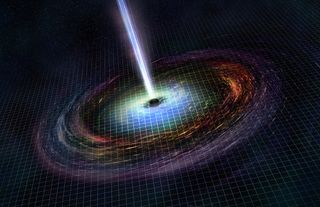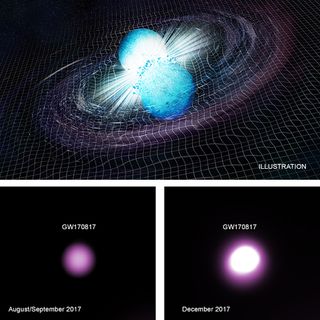Did a Neutron-Star Collision Make a Black Hole?
In August 2017, for the first time ever, scientists spotted gravitational waves generated by the merger of two superdense stellar corpses known as neutron stars.
This landmark find was a major step forward in understanding the cosmos, astronomers have stressed.
At the time, scientists suggested that this dramatic event, officially cataloged as GW170817, could have created a black hole — and a new analysis backs this supposition up. [Neutron-Star Crash: A Gravitational Waves Discovery in Pictures]
In the new study, researchers analyzed data gathered by NASA's Chandra X-ray Observatoryafter the gravitational waves — ripples in space-time first predicted by Albert Einstein a century ago — were detected by the Laser Interferometer Gravitational Wave Observatory (LIGO) project.

LIGO data revealed that the object created by the neutron-star merger is about 2.7 times the mass of the sun. It is therefore either the lowest-mass black hole ever identified, or the most massive neutron star, the researchers said.
But the study team is putting its money on the black-hole interpretation. If the two neutron stars collided to form a single, heavier neutron star, the resulting object would likely have a strong magnetic field that produces bright X-ray emissions, researchers said. However, the Chandra observations revealed low X-ray levels.

"We may have answered one of the most basic questions about this dazzling event: What did it make?" study co-author Pawan Kumar, of the University of Texas at Austin, said in a statement. "Astronomers have long suspected that neutron star mergers would form a black hole and produce bursts of radiation, but we lacked a strong case for it until now."
Get the Space.com Newsletter
Breaking space news, the latest updates on rocket launches, skywatching events and more!
If this hypothesis is confirmed, it could shed light on black holes, the darkest objects in the universe. (The lightest-known black holes harbor a minimum of four to five times the mass of the sun.)

Not all black holes form the same way, but this ultra-low-mass black hole would have taken shape after two supernova explosions left two neutron stars in a close-enough orbit for gravitational-wave radiation to help them collide — a strange and complicated journey, study team members said.
It would also be very interesting if astronomers determined that GW170817 generated a single gigantic neutron star. Such a result would challenge theories about the structure and formation of these exotic objects, researchers said."GW170817 is the astronomical event that keeps on giving," study co-author J. Craig Wheeler, also of the University of Texas, said in the statement. "We are learning so much about the astrophysics of the densest known objects from this one event."
Fellow study co-author Bruce Grossan, of the University of California at Berkeley, voiced similar sentiments.
"At the beginning of my career, astronomers could only observe neutron stars and black holes in our own galaxy, and now we are observing these exotic stars across the cosmos," Grossan said. "What an exciting time to be alive, to see instruments like LIGO and Chandra showing us so many thrilling things nature has to offer."
The new study was published online May 31 in The Astrophysical Journal Letters.
Email Chelsea Gohd at cgohd@space.com or follow her @chelsea_gohd. Follow us @Spacedotcom, Facebook and Google+. Original article on Space.com.
Join our Space Forums to keep talking space on the latest missions, night sky and more! And if you have a news tip, correction or comment, let us know at: community@space.com.

Chelsea “Foxanne” Gohd joined Space.com in 2018 and is now a Senior Writer, writing about everything from climate change to planetary science and human spaceflight in both articles and on-camera in videos. With a degree in Public Health and biological sciences, Chelsea has written and worked for institutions including the American Museum of Natural History, Scientific American, Discover Magazine Blog, Astronomy Magazine and Live Science. When not writing, editing or filming something space-y, Chelsea "Foxanne" Gohd is writing music and performing as Foxanne, even launching a song to space in 2021 with Inspiration4. You can follow her on Twitter @chelsea_gohd and @foxannemusic.
